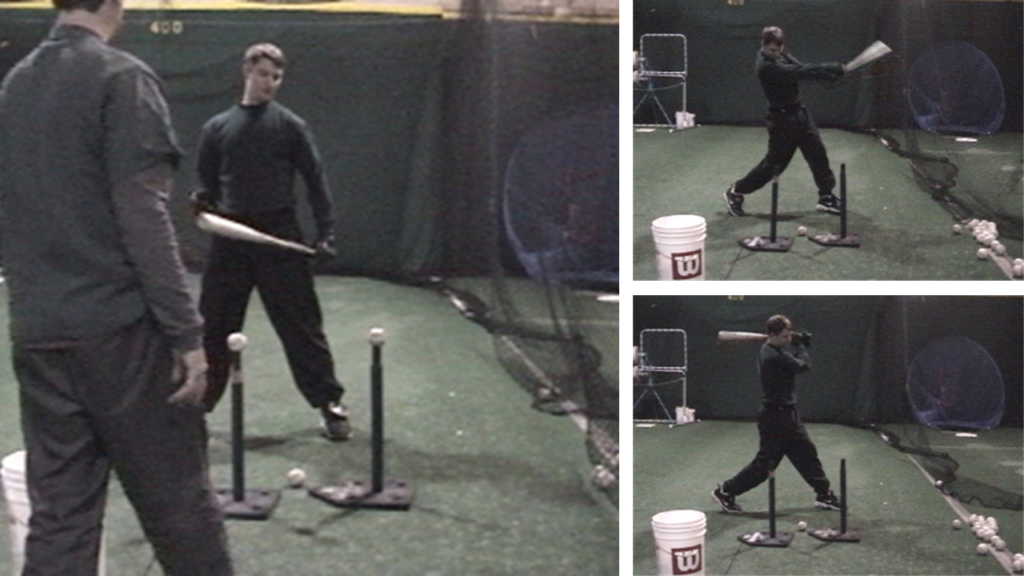
The Spatial Nature of the Strike Zone and the Single Arc Swing
By Ken Cherryhomes ©2025
Much of hitting instruction is clouded by complexity—mechanical tweaks, situational cues, and contradictory advice about swing adjustments. But at its core, the act of hitting is spatial. The strike zone is a three-dimensional volume, and a properly sequenced, consistent swing arc—an “A” swing—can reach every location in that space without altering swing path or posture. This article outlines how a single, unchanging swing arc can cover the full strike zone, relying only on contact depth, wrist articulation, and the natural variations in barrel orientation that follow.

In this 2001 session with Tampa Bay’s Jared Sandberg, a two-tee drill demonstrates how a single swing path can produce multiple outcomes. With Sandberg targeting the outside pitch—earlier in his swing arc geometry—both balls are struck in one motion along the same arc, each at a different contact point depth with distinct spray trajectories. The drill isolates the spatial nature of contact without requiring biomechanical adjustment.
Single Arc, Multiple Outcomes

This 3D model visualizes five mapped contact points across a single, fixed swing arc—outside, middle-away, middle, middle-in, and inside. The swing path does not change. Contact point along the arc determines the outcome.
The 3D illustration depicts a fixed swing arc intersecting five distinct pitch locations—outside, middle-away, middle, middle-in, and inside. The swing arc itself does not change. The batter’s posture does not change. What changes is the point of contact along the arc.
- Outside pitches are contacted earlier in the arc, deeper in the hitting zone.
- Middle pitches are contacted at the apex of the arc—the swing’s geometric center.
- Inside pitches are contacted later in the arc, farther forward in the hitting zone.
This is not about reaction time. No ball is arriving. This is a spatial mapping—a visual proof that a single swing path, if properly aligned, can drive pitches across the entire plate.

Live batting practice at 90+ mph shows that consistent swing arcs can yield different results without altering posture or path. These swings appear identical, but contact occurs at different points, producing distinct spray angles.
Wrist Articulation Enables Full-Zone Coverage
Because the swing arc is consistent, barrel alignment across different pitch heights and positions is achieved through vertical bat angle (VBA) control. That control comes from wrist articulation, not from altering body posture or swing mechanics.
- The wrists hinge naturally to adjust VBA.
- This maintains flush contact across all five mapped locations.
- No swing theory or mechanical overhaul is required—just anatomical accommodation along a fixed path.
This is not manipulation. It’s orientation. And it’s automatic when swing direction is initiated forward and kept consistent.
Spray Angles and Attack Angles: Byproducts of Contact Point
Spray angle and attack angle are not consciously manipulated; they emerge from the geometry of the arc:
- As contact occurs earlier or later in the arc, spray angle shifts accordingly—outside pitches travel the opposite way, inside pitches are pulled.
- Attack angle varies based on the slope of the arc at the moment of contact, changing with location and depth.
These changes are predictable, consistent, and spatially governed. They are outcomes, not inputs.
* When a pitch is recognized early, slight path deviations can occur as a natural response to the batter’s intent to influence ball flight. These deviations are not mechanical overhauls—they occur when a hitter’s conscious intent works in sync with an automatic swing pattern, allowing for subtle adjustments without compromising swing integrity. This could show up situationally, where the hitter affects attack angle to lift a pitch or the swing arc is broadened to influence spray angle.

This true-to-scale 3D spatial grid illustrates all 25 potential pitch locations and the contact points they produce along a single swing arc. Variations in vertical bat angle occur naturally based on pitch height and do not require mechanical adjustment.
Conclusion: Spatial Truth, No Mechanical Excuse
When swing arc and contact depth are understood as spatial absolutes, there’s no need to teach swing compensation. A hitter with a consistent arc and stable posture can drive any pitch in the zone by matching depth and orientation—nothing more.
This is not about feel, timing, or anticipation.
This is about position in space.
One arc. One posture. Five natural outcomes.
The swing doesn’t change. The contact point does.